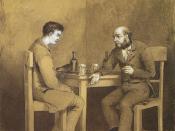Crime and Punishment was the second of Fyodor Dostoevsky's most important, mature fictional works. It was first published in the conservative journal The Russian Messenger, appearing in twelve monthly installments in 1866. Dostoevsky left three full notebooks of materials pertinent to Crime and Punishment. These have been published under the title The Notebooks for Crime and Punishment, edited and translated by Edward Wasiolek. Dostoevsky began work on this novel in the summer of 1865. He originally planned to title it The Drunkards, but in the final version, the theme of drunkenness as a social problem, represented by the Marmeladov family, had shrunk to a minor role. In September of 1865 Dostoevsky wrote a letter to M. N. Katkov, the editor of The Russian Messenger, attempting to persuade Katkov to accept the novel and to publish it in his journal. To show Katkov that the new novel was suitable for publication in a conservative journal, Dostoevsky outlined its content and idea as follows:
The idea of the novel cannot, as far as I can see, contradict the tenor of your journal; in fact, the very opposite is true.
The novel is a psycho- logical account of a crime. A young man of middle-class origin who is living in dire need is expelled from the university. From superficial and weak thinking, having been influenced by certain "unfinished" ideas in the air, he decides to get himself out of a difficult situation quickly by killing an old woman, a usurer and widow of a government servant. The old woman is crazy, deaf, sick, greedy, and evil. She charges scandalous rates of interest, devours the well-being of others, and, having reduced her younger sister to the state of a servant, oppresses her with work. She is good for nothing. "Why does she...


